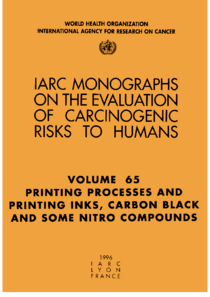Printing processes and printing inks, carbon black and some nitro compounds

International Agency for Research on Cancer, Lyon
IARC - Lyon
1995
578 p.
carcinogens ; inks ; nitroso compounds ; printing industry
IARC Monographs on the evaluation of carcinogenic risks to humans
65
Chemicals
English
Charts;Index
92-832-1265-7
"Evaluates the carcinogenic risks to humans posed by exposures in printing processes and to printing inks, to carbon black, and to selected nitro compounds, many of which are used in the production of dye and colourant intermediates. The first monograph evaluate occupational exposures in printing processes and to printing inks. Exposures in the printing industry are assessed according to their occurrence in printing ink manufacture and in printing operations such as letterpress, lithography, flexography, gravure, and screen printing. Although many epidemiological studies have demonstrated some evidence of cancer risk in printing trades and printing industries, the assessment found several important problems in the design of these studies. Occupational exposures in printing processes were classified as possibly carcinogenic to humans. Printing inks could not be classified. The second monograph evaluates the carcinogenicity of carbon black, an intense black pigment mainly used in tyres and other rubber automotive products, and in many other rubber products. Although the evaluation found sufficient evidence in experimental animals that exposure to carbon black causes lung tumours, data on carcinogenicity to humans were judged inadequate. Carbon black was classified as possibly carcinogenic to humans. The remaining monographs evaluate selected nitro compounds. Of these, 3,7- and 3,9-dinitrofluoranthenes, 2,4- and 2,6-dinitro-toluenes, 2-nitroanisole, nitrobenzene, and tetranitromethane were evaluated as possibly carcinogenic to humans. Chloronitrobenzenes, 3,5-dinitrotoluene, nitrotoluenes, 2,4,6-trinitrotoluene, and musk xylene and musk ambrette could not be classified."
Digital